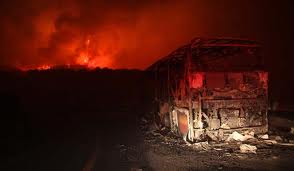By Gabriel Weinstein
 After last week’s forest fire, the Carmel region in Northern Israel’s once emerald forests and fields have become a barren prairie of charred branches, ash heaps and dismembered buildings. The Israeli government estimates it will cost around 2 billion shekels (about $553 million) to repair damage from the fire that claimed 42 lives and destroying almost 50,000 dunams (12,355 acres).
After last week’s forest fire, the Carmel region in Northern Israel’s once emerald forests and fields have become a barren prairie of charred branches, ash heaps and dismembered buildings. The Israeli government estimates it will cost around 2 billion shekels (about $553 million) to repair damage from the fire that claimed 42 lives and destroying almost 50,000 dunams (12,355 acres).
The Carmel fire is poised to join Hurricane Katrina in the pantheon of mishandled natural disasters. Although Katrina provided innumerable lessons for governments on how not to mitigate the damage caused by natural disasters, the Israeli government apparently did not pay attention. As the Israeli government forges ahead with the Carmel fire recovery it is repeating the same mistakes that plagued the U.S. government’s Katrina relief effort.
The wake of the Carmel fire has thrust a longstanding issue, Israel’s substandard fire prevention, into the national and international spotlight. In a report released Wednesday analyzing the government’s military readiness since the debacle of the Second Lebanon War, State Comptroller Micha Lindenstrauss labeled Israel’s Fire and Rescue Services a “weak link.” Lindenstrauss wrote Israel’s firefighting forces are in such disarray “they are in danger of collapsing during a period of emergency.”
Concerns about Israel’s firefighting abilities have been an issue for years. A 2007 State Comptroller’s report on the same subject noted Israeli fire departments’ inadequate equipment, poor bureaucratic structure and lack of manpower could pose serious problems in the event of a major fire emergency. Though in 2008 the Knesset voted to form a national fire and rescue agency to improve fire fighting efforts and Interior Minister Eli Yishai and his predecessor Meir Sheetreet knew about Israel’s firefighting woes, no substantial improvements were made to strengthen the firefighting establishment.
Similar bureaucratic errors marred storm prevention efforts in New Orleans leading up to Katrina. Although the unit of the New Orleans Police Department charged with rescuing citizens in flood situations had asked for more funds and equipment for years, it only had three small boats during Katrina and had no fuel, food or water to provide to aid workers. Federal officials knew the city of New Orleans had not completed plans to properly evacuate 100,000 citizens and a majority of the African-American population. Former Louisiana Transportation Secretary Johnny B. Bradberry told Congressional investigators his department did not have plans to coordinate the evacuation of patients from hospitals and nursing homes.
Both disasters produced a cast of characters who bore the brunt of the blame for the lack of preparation and poor government response. Lindenstrauss singles out Yishai, Sheetreet, Defense Minister Ehud Barak, Finance Minister Yuval Steinitz and Prime Minister Benyamin Netanyahu. New Orleans Mayor C. Ray Nagin, President George W. Bush and Homeland Security Secretary Michael were part of the large cast of villains held responsible following Katrina. But one main figure emerged in each country as the proverbial piñatas for national frustration: former FEMA chief Michael D. Brown in the U.S. and Interior Minister Eli Yishai in Israel.
Brown’s mishandling of Katrina symbolized the chaos surrounding the storm. He allegedly chose to ignore warnings from FEMA official Marty Bahamonde about Katrina’s severity while the storm morphed into an unstoppable behemoth. Instead of discussing strategy with Bahamonde as the storm gained power in New Orleans, Brown had a leisurely meal at a Baton Rouge restaurant. His lackadaisical response to Katrina led to his resignation from FEMA in September 2005. In a congressional hearing on Katrina in October 2005, Brown pinned the blame on Ray Nagin, Louisiana governor Kathleen Blanco and the Bush administration.
Yishai is experiencing similar treatment to Brown in the immediate aftermath of the Carmel fires. Lindenstrauss holds Yishai most accountable for the pandemonium and inefficient response to the fires writing “I find it right to alert the Israeli government and the prime minister of the ongoing omission which lies first and foremost at the Interior Ministry’s door and that of the man at its head.” Yishai has proclaimed that he, Netanyahu, Barak and Steinitz should all share equal blame for the handling of the disaster. He has also contended that he is being unfairly criticized because of his Haredi identity.
Though the Knesset approved a new law to revamp the structure of Israel’s fire services it remains to be seen whether the government will actually pursue it and if the law will have any effect. Hopefully the Israeli government (and all governments, for that matter) will apply the lessons from Katrina and the Carmel fires and revamp their relief strategies before disaster strikes. This would be a welcome change.
